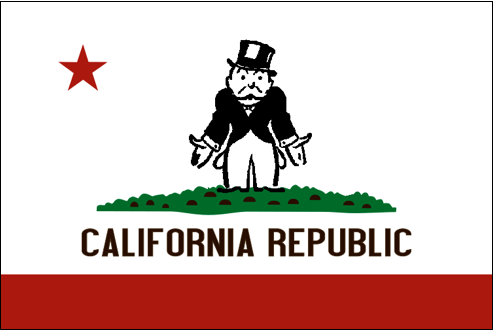The state of California accounts for 22 percent of all regular unemployment claims and a whopping 49 percent of all pandemic unemployment claims, despite only accounting for 15.2 percent of the working age U.S. population, data from the Department of Labor shows.
In an unusual explosion of activity, 4.4 million of its 6.97 million continued pandemic unemployment claims appeared in the Department of Labor database since July 25 alone (3.9 million since Aug. 22) — even while confirmed COVID-19 cases have been declining the past month and the state has been easing restrictions on businesses to reopen.
In fact, if you add up all the initial claims for the pandemic unemployment assistance program in California for the entire year through Aug. 22 you only get 2.4 million, but the continued pandemic claims add up to 6.97 million for the state. This is a clear discrepancy that must either be a massive accounting error or else widespread fraud, since there appear to be more continued claims than total initial applications. In other words, there are more people collecting benefits than who applied for the benefit.
In addition, initial pandemic unemployment claims have more than doubled to 405,878 the week of Aug. 29 from two weeks prior.
“We do suspect that a big part of the unusual recent rise in P.U.A. claims is linked to fraud,” said Loree Levy, a spokeswoman for the California Employment Development Department in an interview with the New York Times published Sept. 11.
Now, the fact that there is fraud in the pandemic unemployment claims process is not surprising, with the program’s eligibility criteria being less stringent than regular unemployment. It includes an element of self-certification in order to qualify, and the state of California is clearly not confirming eligibility.
In fact, according to a Department of Labor Inspector General report from May, this fraud was anticipated and predicted by department watchdogs: “The CARES Act’s Pandemic Unemployment Assistance (PUA) program expanded UI eligibility to individuals who are not typically qualified to receive such benefits. To establish eligibility, the CARES Act requires individuals to self-certify that they have lost employment income due to a COVID-19 related reason specified within the statute. This self-certification renders the individual eligible to receive payments immediately.” In other words, there is no immediate eligibility check required by the statute that the Department of Labor or states are supposed to implement.
The report continues: “Costs for PUA benefits are currently estimated to total nearly 110 billion dollars. The associated risk of improper payments and fraud is significant, as the UI program historically experiences some of the highest improper payment rates within the federal government. The Office of Inspector General (OIG) believes state’s reliance on self-certifications alone to ensure eligibility for PUA will lead to increased improper payments and fraud.”
Adding to the mystery, in some cases benefits recipients may not even be receiving some of the benefits, with some being sent to empty mailboxes. According to the New York Times report: “Two weeks ago, shortly after she advertised an apartment for rent in the Bay Area, Barbara Lamb found five envelopes from the state’s unemployment office in the building’s communal mail slot. They kept coming, day after day, until a stack of more than 30 piled up, bulging with notices of benefit approvals, questionnaires about job status — and debit cards with money… But Ms. Lamb had not applied for benefits, and had never heard of the people to whom the envelopes were sent. Fearing the address of the vacant unit was being used as part of a fraud scheme to collect the money, she contacted the F.B.I.”
The California Employment Development Department (EDD) on Sept. 13 issued a statement saying the fraud is being perpetrated by identity thieves: “The EDD is aggressively fighting fraud in the wake of unscrupulous attacks on the unemployment program here in California and across the country. These perpetrators are often using stolen identity information from national and global data breaches, as well as exploiting expedited payment efforts in the federal PUA program. Claims identified as suspected fraud have been suspended or closed while EDD investigators partner with local, state, and federal law enforcement to expose and prosecute offenders to the fullest extent of the law.”
Although, the fraud only seems limited to California. It’s not “across the country” as the EDD contends. When you subtract out California’s Aug. 22 burst of claims, continued pandemic unemployment insurance claims were actually down 500,000 nationally that week, according to the Department of Labor data.
But why send debit cards to unattended mailboxes? How would the fraudsters collect the money? Perhaps if the scheme is not merely tied to financial fraud, perhaps it is intended to possibly, politically impact the reported unemployment rate from the Bureau of Labor Statistics (BLS).
President Donald Trump on Twitter on Sept. 8 suggested that the state lockdowns that have driven unemployment to the moon this year could be extended to keep good economic data from coming out: “The Democrats will open up their states on November 4th, the day after the Election. These shutdowns are ridiculous, and only being done to hurt the economy prior to the most important election, perhaps, in our history!”
Fortunately, the BLS does not draw its monthly employment data from the unemployment insurance claims, at least nationally. According to the BLS website: “Some people think that to get these figures on unemployment, the government uses the number of people collecting unemployment insurance (UI) benefits under state or federal government programs. But some people are still jobless when their benefits run out, and many more are not eligible at all or delay or never apply for benefits. So, quite clearly, UI information cannot be used as a source for complete information on the number of unemployed…”
So instead, per BLS: “Because unemployment insurance records relate only to people who have applied for such benefits, and since it is impractical to count every unemployed person each month, the government conducts a monthly survey called the Current Population Survey (CPS) to measure the extent of unemployment in the country… There are about 60,000 eligible households in the sample for this survey. This translates into approximately 110,000 individuals each month, a large sample compared to public opinion surveys, which usually cover fewer than 2,000 people. The CPS sample is selected so as to be representative of the entire population of the United States.”
Gary Steinberg of the Bureau of Labor Statistics press office quickly confirmed to me via email when I inquired about the discrepancy in data, stating, “Unemployment insurance claims (UI claims) are not used to determine the number of people in the nation unemployed or the national unemployment rate.”
But, Steinberg also reported the BLS does use unemployment claims data for local area unemployment levels and rates, stating, “At the state and local levels, a number of data sources including the unemployment claims data are used to build the local area unemployment levels and rates,” and he referred me to the local area unemployment statistics section of the BLS website.
That section of the website states, “The LAUS program is a hierarchy of non-survey methodologies for producing monthly estimates of civilian labor force, employment, unemployment, and the unemployment rate for over 7,500 subnational areas. Estimates for states are derived from signal-plus-noise models that use the monthly employment and unemployment measures tabulated from the Current Population Survey (CPS) as the primary inputs. Payroll employment estimates from the Current Employment Statistics (CES) survey of establishments and unemployment insurance (UI) claims counts from the state workforce agencies are also used as model inputs to help mitigate volatility in the monthly state-level CPS estimates. These models are controlled, or forced to sum, to the national not-seasonally-adjusted employment and unemployment estimates from the CPS. They furthermore serve as controls for substate areas, so that the monthly estimates are additive and comparable across geographic levels.”
So, it is possible but not necessarily likely that fraudulent unemployment insurance claims could affect the BLS data reported locally. So, why might somebody be interested in potentially rigging that data?
One reason might be that those local area unemployment statistics are used in federal funding formulas. According to the Department of Labor 2021 budget: “Several BLS series are used in the administration of federal programs… Changes in BLS data have direct effects on overall federal budget expenditures, including federal allocations to state and local jurisdictions. Local Area Unemployment Statistics data are used to allocate federal funds from assistance programs to states and local jurisdictions in such areas as employment, training, public works, and welfare assistance.”
Meaning, if the fraudsters were hoping to use unemployment insurance claims to boost the reported unemployment rate, they might be sorely disappointed. In August, when much of the fraud appears to have occurred, the BLS-reported unemployment rate still dropped from 10.2 percent to 8.4 percent, as 13.8 million jobs have been recuperated into the rapidly recovering U.S. economy since labor markets bottomed in April.
If the goal is to potentially impact local area unemployment statistics, the August monthly release of that data series due out in October may well be worth watching, but again potential fraudsters might be similarly disappointed. Nothing in the local area unemployment statistics methodology says it is utilizes pandemic unemployment claims to formulate its estimates. Obviously, it goes without saying that the BLS economists should be highly skeptical of the data coming out of California.
UPDATE, Sept. 15, 4:40p.m.: Another Department of Labor spokesperson has received word from California that the bump in continued pandemic unemployment assistance claims were backlogged, retroactive claims that were delayed “due to difficulties in implementing the new program” and are finally appearing in their own database: “California indicated there were a large number of continued claims reported for backdated weeks of PUA. PUA was implemented retroactively for weeks beginning on or after January 27, 2020. In addition, further need to backdate claims occurred due to the difficulties in implementing the new program combined with the extreme claims volumes in both the regular and PUA programs. As a result, individuals that were unable to file for PUA earlier in the period of eligibility and were eligible for backdated claims were filed and reported in bulk by the state as they were taken because CA’s current reporting system is unable to assign the claims to the week to which they applied. This caused continuing claims to appear to be higher than initial claims.”
The spokesperson emphasized that “one of the important things to understand about the data released weekly is that it is provided by the states.”
Potential data manipulation motives aside, the pandemic unemployment assistance program, particularly in the state of California, with its pitiful self-certification requirement, appears to be running rampant with fraud with billions of dollars being stolen, and it is up to the Justice Department to investigate and bring the thieves to justice.
And it is up to Congress, President Donald Trump and the Department of Labor to rein this program in immediately. Self-certification to receive benefits is a joke.
Robert Romano is the Vice President of Public Policy at Americans for Limited Government.
Correction: California had 2.4 million initial pandemic unemployment claims through Aug. 22, not 2.8 million.







